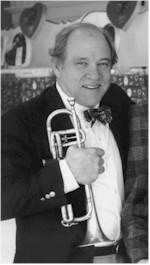There's a question I hear over and
over: "Is that a cornet?" Almost
always, it's followed with: "Why a
cornet and not a trumpet?"
At the present time, there are quite
a number of great cornetists blowing
up a storm: Warren Vaché Jr., Tom
Pletcher, Tommy Saunders, Randy
Reinhart, Peter Ecklund, and my
favorite of all, Bob Barnard. Of
course there are many others.
But why the cornet?
Louis Armstrong himself, 30 years
after his death, now finally
acknowledged as the greatest of all
contributors to jazz, showed his
clear preference for the trumpet.
Louis' soaring trumpet was the
inspiration for all the great swing
era trumpet stars. As a group, they
completely dominated jazz brass
playing. A list of the most famous
in this camp would include Bunny
Berrigan, Ziggy Elman, Hot Lips
Page, Yank Lawson, Pee Wee Erwin,
Charlie Shavers, Billy Butterfield,
and Harry James. All were serious
trumpet players and serious
disciples of Louis.
With the exception of Wild Bill
Davison, the only well-known jazz
cornet players of those days were
those who were so captivated by the
beautiful cornet tone of Bix
Beiderbecke that they chased that
elusive holy grail throughout their
careers and stuck with their
cornets. It was the sound that they
were after. There were not many:
Bobby Hackett, Maxie Kaminsky, Jimmy
McPartland. A few others played the
cornet from time to time, but were
mostly trumpet players. Rex Stewart
and Ray Nance come to mind. None
were big stars, although Hackett
finally sort of hit it in the 1950s
with his solos on the Jackie Gleason
records.
Many of us who are followers of both
the Armstrong and Beiderbecke
traditions end up with collections
of cornets and trumpets. At one
point I was carrying three gig bags
around--one with a trumpet, one with
a flugelhorn and one with a cornet.
In 1979, our band made its first
visit to Europe where we played for
a couple of festivals, including the
annual Breda Festival in Holland.
There I found a very high-powered
flea market selling instruments at
high prices. On a whim, I stopped by
with my trumpet and flugelhorn and
negotiated. They went on sale and
were gone in an hour. I've been
strictly a cornetist ever since.
My pockets lined with flea market
cash, I beaded for Paris and the
factory of the Courtois Company,
makers of fine cornets. Courtois is
the oldest instrument maker in the
world, and they will proudly tell
you that they made brass instruments
as far back as the late 1700s (they
even made instruments for Napoleon).
The Courtois factory on Rue de
Nancy, Paris is quite amazing.
There, about five workmen still
hand-hammer bells. It is obvious
that everything in the shop is quite
old. As I remarked on this, the
owner exclaimed, "Oh, this our new
place. We moved here in 1860!" Soon
I was on my way with two shiny new
Courtois Cornets.
That night, my Parisian pal Pierre
Atlao took me around to sit in at
several "Caves" (basement jazz
bistros thick with smoke--there are
still some in Paris today). At the
famed "Slow Club" we found the even
more famed soprano saxophonist
Claude Luter and his band.
As I showed off my new Courtois
cornets, Luter laughed. The French
brass players can't wait to get
their hands on American instruments,
he said while here I was in Paris
chasing Courtois cornets on Rue de
Nancy.
Why the cornet? It's the sound, the
flexibility, and also I'd say its
the magic of the Beiderbecke model.
I now have quite a collection of
cornets. In a later
Jazz Me News, I'll run down
the list. Each comes with an
interesting story.
What About the Cornet? By Jim Cullum Jr


